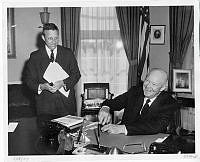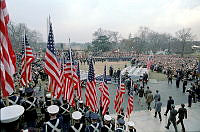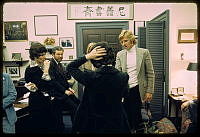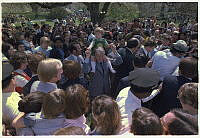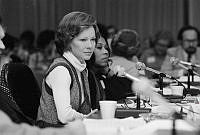The Floating White House
Copyright © May 21, 2015 White House Historical Association. All rights reserved under international copyright conventions. No part of this article may be reproduced or utilized in any form or by any means, electronic or mechanical, including photocopying, recording, or by any information storage and retrieval system, without permission in writing from the publisher. Requests for reprint permissions should be addressed to books@whha.org
Presidential yachts sail now on a sea of memories, long sleek ships that were once symbols of the presidency, tools of diplomacy, centers of hospitality, and breezy salt-air retreats from the steamy heat of a Washington summer. But for nearly a century, presidents looking for an easy escape from the strains and tensions of the White House found one on the deck of a government yacht.
Beginning with USS Despatch in 1880, a succession of yachts awaited the pleasure of every commander in chief from Rutherford B. Hayes to Gerald R. Ford. The roster includes Dolphin, Sylph, Mayflower, Potomac, Sequoia, Williamsburg, Honey Fitz, and the only sailboat on the list, John F. Kennedy’s 62-foot Manitou, an ocean racer on loan from the Coast Guard.

The presidential yacht USS Sylph, c. 1910-1915.
Their era ended in 1977 when President Jimmy Carter, seeking to end what he called the “imperial presidency,” sold the last of them, USS Sequoia, a yacht used by every president since Franklin Roosevelt.

The presidential yacht, USS Sequoia, in a 2009 image taken by the U.S. Navy.
Once on board, American chief executives cruised from Maine to the Caribbean, explored the Potomac and Chesapeake Bay, reviewed the fleet, received royalty, conferred with allies, thought through future plans—or just loafed, played poker, or went fishing.
Theodore Roosevelt used the 273-foot Mayflower as an instrument of personal diplomacy in the 1905 negotiations that ended the Russo-Japanese War and earned him the Nobel Peace Prize.
Woodrow Wilson, a White House widower, courted Edith Bolling Galt aboard Mayflower. During World War I, Wilson used the yacht to escape “people and their intolerable excitements and demands.”

Presidential yacht USS Mayflower, pictured in 1909.
In the months before the United States entered World War II, Franklin Roosevelt deployed Potomac in a nautical shell game to cloak a secret rendezvous at sea with British Prime Minister Winston Churchill.
Harry S. Truman found Williamsburg a pleasant setting for an afternoon nap or a convivial game of poker, but was far less happy when she bucked and pitched in the open ocean. Williamsburg supported Truman’s 11 vacations at Key West, Florida, serving as a communications center and providing cabins for the president’s overnight guests.

While on the way to Bermuda, President Harry S. Truman returns to the USS Williamsburg after a morning swim, August 1946.
Under siege during the Watergate scandal in the late summer of 1974, Richard M. Nixon boarded the Sequoia, cruised on the Potomac and pondered resigning rather than face impeachment. But the seclusion he sought proved an illusion. “When we passed under the bridges, reporters and photographers would suddenly surge forward hanging perilously over the railings, trying to get a closer glimpse or a closer picture,” Nixon recalled.
“We were the subject of a deathwatch,” his daughter Julie concluded. “Being on the Sequoia was like bobbing along in a glass bottle.”
John F. Kennedy’s hours on the water were far less stressful. Here’s an account from Kennedy aide Theodore Sorensen:
“On board either the family or the presidential cruiser the president read history or biography or fiction, chatted with family and friends, waved at passing boats, watched local sailing races and enjoyed the distance between himself and the Secret Service” who trailed him on an escort vessel.

President John F. Kennedy smokes a cigar and reads a newspaper aboard the presidential yacht Honey Fitz in August 1963.
Grandest of them all, Mayflower was manned by eight officers and 166 men, including musicians. Its reception rooms were paneled in white and gold. The dining table sat thirty.
William Howard Taft’s wife, Helen, verged on the poetic as she described the yacht’s cruise along the Maine coast in the summer of 1910. In a memoir she drew a word portrait of “the Mayflower steaming among the crags and rocks of the broken, picturesque coast, or lying at anchor in some quiet harbor with only the soft water sounds to break the stillness.”
“I know of no other way for (a president) to get short intervals of rest than by boarding the presidential yacht and steaming away out of the reach of crowds,” she said in a memoir. "Mayflower," she said, would work well for any American president, “if he happens to be a good sailor.”
Years later, President Calvin Coolidge, decidedly queasy after a long afternoon in rolling seas reviewing passing battleships, sank, grim-lipped, into a Mayflower deck chair and managed a final salute, the fingers of his right hand touching his favorite yachting cap. A photographer chose that moment to snap a picture.

During their visits home from boarding school to the White House, the Coolidge boys joined their parents for sailing trips on the Mayflower. From left to right: Calvin Coolidge, Jr., First Lady Grace Coolidge, President Calvin Coolidge and John Coolidge on board the Mayflower, in September 1923.
In March 1941, Franklin Roosevelt leaned into a radio microphone on board Potomac after a cruise in Florida’s Gulf Stream. He told his audience that a short escape to salt water offered “a chance for a bit of sunshine or a wetted line, or a biography or a detective story or a nap after lunch.”
But above all, he said, a cruise out of sight of land, provides a president an important opportunity “for thinking things through,” for sifting through all that lies ahead and deciding what is important and what is not.

President Franklin Roosevelt with U.S. Naval Academy Superintendent Admiral Foote Sellers aboard the yacht USS Sequoia in 1935.
Library of Congress













